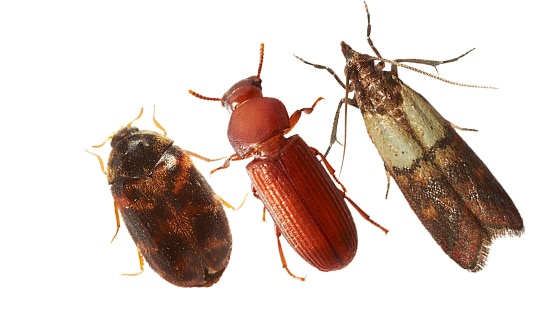Pest of the Quarter: Stored Product Pests
The Pest Monitor Newsletter

Ever since the khapra beetle was been detected in the U.S., massive, long-term, costly control has been required to eradicate it. However, this stored product pest is just one of more than 60 species in North America alone that infest foods. And, like eradication efforts for the khapra beetle, many stored product pests are difficult to detect until an infestation builds – at which time they can be difficult to control.
Stored product pests are beetles, weevils and moths that breed and feed on or in both processed and non-processed foods. Primarily pests of grains and seeds, they will infest foods such as pasta, flour, cereal, pet foods, dry milk, grains, spices, baked goods and other dry goods. When not detected and eliminated, the insects can damage foods so they are no longer fit for consumption and must be destroyed.
Because of this, stored product pests can extensively impact a food facility’s business through product loss as well as treatment costs. They can also impact audit scores causing deductions, and lead to consumer complaints, affecting your brand reputation.
There are four categories of stored product pests, with each having its own specific characteristics and behaviors:
- Internal Feeders. Insects lay their eggs within the grain so the larvae can feed on the product.
- Scavengers. Insects feed on the grain after the shell is broken by mechanical means or by other insects.
- External Feeders. Insects feed on the outside surface of grain kernels and also may chew through them.
- Secondary. Insects feed on deteriorating, moldy materials.
Stored product pests most commonly enter a food facility in or on infested material that is brought into the facility or through open entries or gaps/holes from the outdoors. Once inside, they can thrive in storage areas, particularly if first-in/first-out product rotation is not conducted, or product is kept beyond its shelf life. Insect survival also can be aided through inefficient cleaning and sanitation of the structure and equipment, particularly of hard-to-clean areas where debris can accumulate and insects harbor.
With the FDA and USDA taking a zero-tolerance approach to pests, it is more important than ever to ensure against stored product pest presence. Through a comprehensive partnership that includes a thorough inspection for pest presence and conditions conducive to their activity, proper identification, continual monitoring, and implementation of best prevention practices, stored product pests can be controlled and eliminated.
For information about a targeted IPM program, visit Ecolab's Food Protect page.


